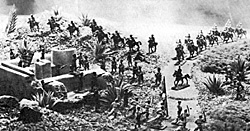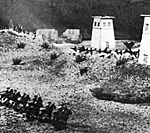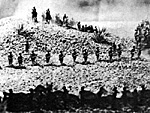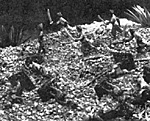
- Walk wide o' the Widow at Windsor
For 'elf o' Creation she owns:
We 'ave brought 'er the same with the sword an' the Flame,
An' we've salted it down with our bones.
Gunga Din, Lives of the Bengal Lancers, Zulu -- the romance and ferocity of warfare in the age of Empire are familiar to most. However, a true reproduction of these and other elements in wargaming have been largely lacking. Several sets of rules attempt this and come close, but woe to the person who fights as the 'eathen.
The British, once they deploy, make short work of the natives with their martini-henrys, gatlings and screw-guns. Yaquinto Publications' THE SWORD AND THE FLAME, though not exactly what the natives ordered, at least gives a balanced game in which the result is far from pre-ordained.
THE SWORD AND THE FLAME offers an intriguing alternative to the large scale colonial games requiring hundreds of figures to each side. Granted, the natives still need the numbers (as much as three to one), but the British do not. The Imperial troops must stay the hordes with their skill and pluck!
- With home-bred hordes the hillsides
teem.
The troopships bring us one by one,
At vast expense of time and steam,
To slay Afridis where they run.
The ''captives of bow and spear"
Are cheap, alas! as we are dear.
 he British rely on superiority of firepower and in
staying ability. Sad is the English general that throws
away these advantages! The English commander
who forgets to think, will often see the plains, and
hills, "salted" with Colonial casualties.
he British rely on superiority of firepower and in
staying ability. Sad is the English general that throws
away these advantages! The English commander
who forgets to think, will often see the plains, and
hills, "salted" with Colonial casualties.
Unique fire-tables allow the British to do more damage with less firing, however some of the native forces can be quite deadly. If they stand in melee, they can be devastating!
Casualties are not just "taken" either. Figures are killed, or wounded. Also, the leaders can be killed, leading to problems of morale and movement. Here the British staying power and training is built in by giving them two leaders per unit. The natives only get one per unit. In this way, the Imperial unit continues to function, unless extremely unlucky, while taking fearsome casualties. The natives are extremely shaky if their chief is lost.
All figures are on individual stands. This lends to the flow and flexibility of this type of warfare. It also allows wounded to be laid down on the field, to be left for the enemy, or carried to the rear. A wounded man left on the field has a harsh reality to face -- torture. The natives were not reluctant to torture the British captives.
As Kipling wrote;
- When you're wounded and left on
Afghanistan's plains,
And the women come out to cut up what remains,
Jest roll to your rifle and blow out your brains
An' go to your Gawd like a soldier.
These rules allow for just such eventualities. If it does happen, morale can suffer, reflecting the fact that the English were very careful to protect wounded for fear that their native contingents would feel that they were being sacrificed by the white man. On the opposite side, a valorous action can win a Victoria Cross.
 Movement and fire are determined randomly by using a deck of cards. The red cards traditionally being a British move or fire card, and the natives use the black cards. While not totally realistic, the cards do offer elements of initiative and surprise not often found in sequenced movement games. This randomness, coupled with a variable move distance determined by rolling dice, allows sudden outflanking, outwitting, and outpositioning. The random fire allows the critical element of getting in the "first shot."
Movement and fire are determined randomly by using a deck of cards. The red cards traditionally being a British move or fire card, and the natives use the black cards. While not totally realistic, the cards do offer elements of initiative and surprise not often found in sequenced movement games. This randomness, coupled with a variable move distance determined by rolling dice, allows sudden outflanking, outwitting, and outpositioning. The random fire allows the critical element of getting in the "first shot."
The Jackson, Mississippi wargame group has used these rules in 30 actions. The natives have bested the Imperial forces half the time, varying on the period fought. The following "Battle of the Malakar Pass" was hard fought, and a narrow Imperial victory.
The action was fought on a 12 by 6 foot table using terrain formed of "kitty-litter" covered foam hills, small rocks representing broken ground, shag- carpet pieces for scrub brush and cardboard buildings. Four players fought on each side, with one per side being overall commander. His responsibilities included designating move and fire sequence, as well as dispositions and objectives.
The sides, British against Pathan, were closer than normal, the British having 93 figures to the Pathan 161. The forces were:
| BRITISH | PATHAN |
|---|---|
| A. Bengal Lancers (12) | 1. Ambeylas (21) |
| B. Mtn Gun and Crew (4) | 2. Waziris (21) |
| C. Plt of the "Buffs" (20) | 3. Afridis (21) |
| D. Plt of the "Guides" (20) | 4. Chitralis (21) |
| E. Plt of the "Ghurkas" (20) | 5. Swatzais (21) |
| F. Gatling gun and crew (4) | 6. Baluchi (12) |
| G. 10th Hussars (12) | 7. Baluchis (21) |
| Mounted Command figure (1) | 8. Mushads (21) |
| - | Two mounted chiefs |
| Total figures -- 93 | Total figures -- 161 |
BRITISH SITUATION
The British would enter on the south edge of the table, unit by unit as movement cards turned up.
All of their troops would be exposed to view. Their mission was to secure the ridgeline two feet to each side of the pass. There was no time limit. They were told to expect to find 6 to 10 Pathan tribes guarding the pass. If the pass could not be secured, they were to give up the mission and withdraw minimizing casualties.
PATHAN SITUATION
 The Afghanis were told that the British force
would be entering the south edge. They were also
told that the ridge, or part of it would likely be their
objective. The Pathans could set up on the board,
up to two feet in.
The Afghanis were told that the British force
would be entering the south edge. They were also
told that the ridge, or part of it would likely be their
objective. The Pathans could set up on the board,
up to two feet in.
Pathans could start concealed behind ridges, in scrub, in buildings and in entrenchments until the British were within 12 inches. Afghanis had to be exposed if they fired. Up to three tribes could be held off the table "in reserve." These could be committed on any turn after the first Pathan unit routed from the field.
INITIAL DISPOSITIONS
The British commander was somewhat less experienced with the rules than the Pathan commander. Perhaps because of that fact, the Redcoats were committed to a frontal assualt. Artillery and Gatling fire would suppress the natives, while the cavalry was posted on the flanks.
The Pathan leader, who had beat the British a number of times, guessed that the pass was relevant to the English victory. He placed entrenchments on the ridges above the pass, while concealing units in the ruins behind the ridgeline. Three tribes, including his cavalry, were kept in reserve off-table. These were off the extreme right flank -- hoping for the decisive counter-attack. His left was slightly refused.
FIRST PHASE
The Imperial troops advanced forward getting their mountain gun (B) on the hill and the Gatling (F) within range of the ridge. As the British closed to rifle range (24 inches) the Swatzais (5), Chitralis (4) and the Afridis (3) rose and opened fire. In the exchange the British poured the massed fire of the Gatling, Screw-gun and rifles into the entrenchments. The Chitrali's only leader was felled, causing them to flee the battleground.
The Pathan reserves, freed to enter the fray, moved in unknown to the English. The three Afgani units (6, 7 and 8) moved into position on their right. The Pathan chief also moved the Ambeylas (1) from behind the ridge into some scrub on his left.
SECOND PHASE
The Imperial infantry pressed in on the Pathans in a general assualt. The Ghurkas (E) drove the Afridis (3) from the entrenchments. Shorn of that protection, the Afridis also quit the action. The Guides (D) moved into the pass and the Buffs (C) moved against the Swatzais (5), engaging them in a close firefight.
 As the British infantry pressed in, the Pathans
sprang on both flanks. On their left, the Ambeylas
(1) attempted to contact the Gatling, but were
pinned by its fire. On their right, the Baluchis (6 and
7) and Mushads (8) moved in fast, unopposed by
the British cavalry.
As the British infantry pressed in, the Pathans
sprang on both flanks. On their left, the Ambeylas
(1) attempted to contact the Gatling, but were
pinned by its fire. On their right, the Baluchis (6 and
7) and Mushads (8) moved in fast, unopposed by
the British cavalry.
FINAL PHASE
The Imperial forces faced the rushing Pathans on two sides. The Baluchis (6 and 7) and the Mushads (8) forced the screw-gun to displace. The Bengal Lancers (A) mounted a hurried counter-charge against the Baluchi cavalry (6). Losing the melee, the Lancers were driven back, though the Baluchis were badly hurt.
On their right flank, however, the British fortunes held. The Tenth Hussars (G) pushed the shaken Ambeylas (1) back. The Buffs (C) forced the Swatzais (5) to retire back along the ridge, while the Guides (D) repulsed a ferocious hand-to-hand assault by the Waziri tribe (2). The Guide's lieutenant was distinguished in the action and was awarded the Victoria Cross.
Regardless of their smashed left flank, the British were now firmly in control of the pass. The Pathans, bloody, but still proud, withdrew. The battle ended with a narrow Imperial victory.
CRITIQUE
The British came within one melee of losing. They had taken almost 50% casualties (the Guides were down to seven effectiveness). Determined though the frontal attack was, the Pathan flanks would have proved softer. Also, British defense of their own flanks was not given enough thought. Both were nearly overwhelmed.
The Pathan plan of the strong flank attack was outstanding. Because the Pathans can move swiftly and secretly, the English were caught flat-footed. If the Afridis had not fled the ridgeline in front, their flank attacks would have corked a British filled bottle. By staying in the hills, and in concealment, the Afgani leader nullified superior British firepower, especially that of the artillery.
 The storming of the Malakar Pass was a
realistic exercise in colonial warfare. The ability of
the British to "push on" while under the handicaps of
severe casualties and an uninspired battle-plan, to
seize a hardened objective, was and is
characteristic. The inability of the Pathans to hold
those positions due to disheartened units giving up
was also characteristic -- as was the stealth with
which they operated. They'll go on to another battle
more suited to their fortunes.
The storming of the Malakar Pass was a
realistic exercise in colonial warfare. The ability of
the British to "push on" while under the handicaps of
severe casualties and an uninspired battle-plan, to
seize a hardened objective, was and is
characteristic. The inability of the Pathans to hold
those positions due to disheartened units giving up
was also characteristic -- as was the stealth with
which they operated. They'll go on to another battle
more suited to their fortunes.
The Pathan-British action is one of four periods suggested by the rules. The others being, Zulu- British, Dervish-British and first Boer war Boer and British. Other periods can easily be fought with these rules.
THE SWORD AND THE FLAME is especially serviceable for beginners. Not only because the rules are easy and playable, but also because the author has included organizations and uniform guides. Huge armies are not needed, either. For the experienced gamer, THE SWORD AND THE FLAME offers a highly playable system for colonial actions. If you tend to play the European side because they always win, and you can't stand losing -- your ego will suffer with these rules. For now, it is possible that the natives can defeat the Imperialists. Even Kipling wrote:
-
So 'ere's to you, Fuzzy-Wuzzy, at your 'ome in
the Soudan;
You're a pore benighted 'eathen but a first-class fightin' man;
An 'ere's to you, Fuzzy-Wuzzy, with you 'ayrick 'ead of 'air --
You big black boundin' beggar -- for you broke a British square!
Back to Table of Contents -- Courier Vol. 2 #2
To Courier List of Issues
To MagWeb Master Magazine List
© Copyright 1980 by The Courier Publishing Company.
This article appears in MagWeb (Magazine Web) on the Internet World Wide Web.
Other military history articles and gaming articles are available at http://www.magweb.com